Content
- 1 Characteristics of species of tree peonies
- 2 What do tree-like peonies of yellow varieties look like (with photo)
- 3 The best varieties of red tree peonies for the Moscow region
- 4 Winter-hardy varieties of tree-like peonies in white (with photo)
- 5 Tree peonies in garden landscape design (with photo)
- 6 What tree peonies of different varieties look like: photos, names and descriptions
- 7 How to properly plant a decorative tree peony
- 8 How to grow tree peonies and how to care for them
- 9 Methods for propagating peonies by seeds and cuttings
- 10 How to propagate tree peonies by division, layering and grafting
- 11 The use of tree peonies in landscape design
- 12 Coral altar
- 13 Koshinoyuki
- 14 Primavere
- 15 Purple phoenix
- 16 Purple lotus
- 17 Flower dew
- 18 Black pirate
- 19 Silk veil
- 20 Age of Gold
Characteristics of species of tree peonies
There are 4 known species of these plants:
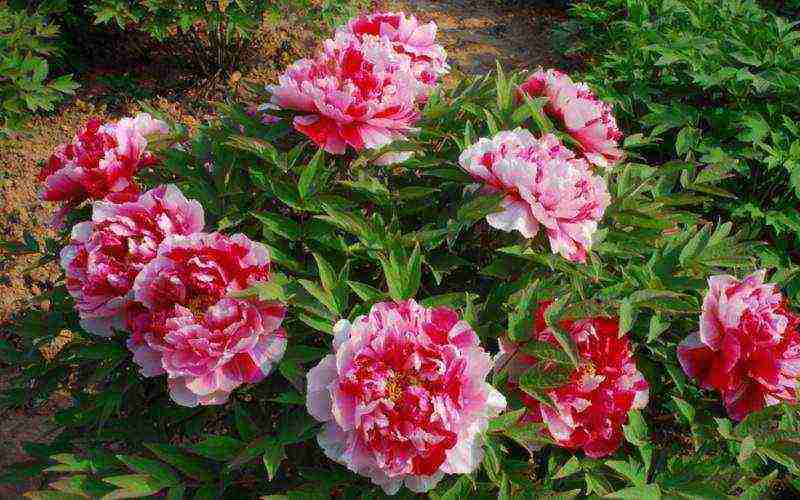
Tree peony in the photo
Tree peony (Paeonia suffruticosa), which gave the name to the whole group
Three types of semi-shrub peonies:
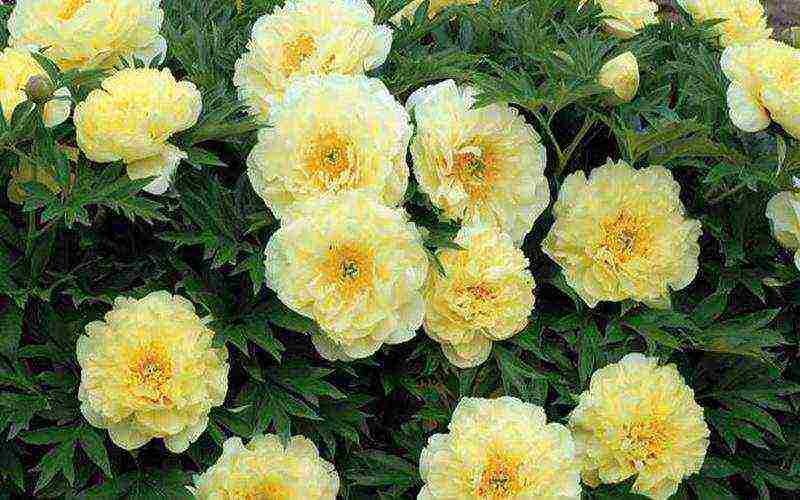
Yellow peony (P. lutea)
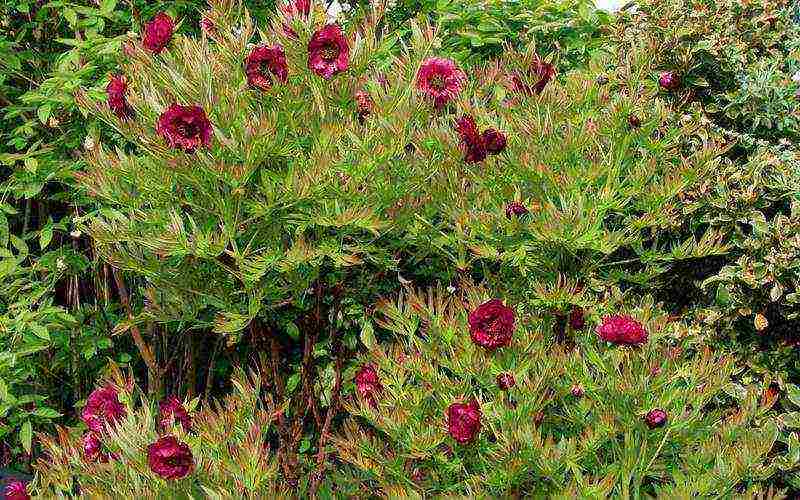
Delaway Peony (P. delavayi)
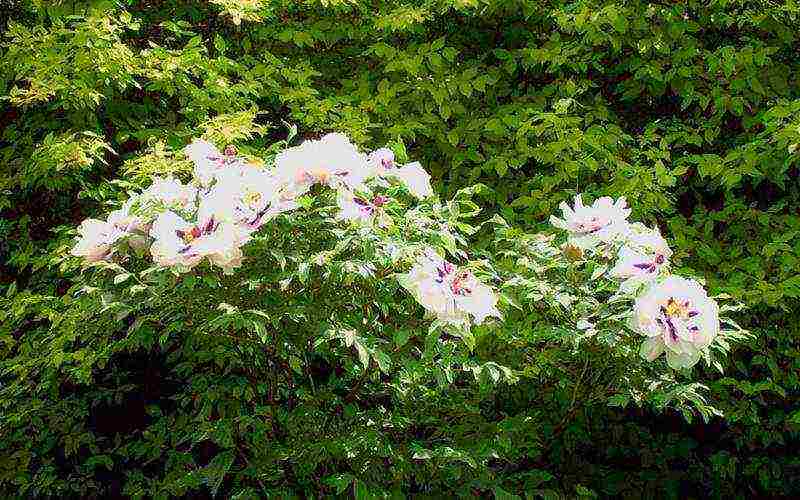
Potanin's peony (P. potaninii)
These photos show the types of tree peonies:
Tree peony, or semi-shrub (P. suffructicosa, aka P. montan and P. arborea, is a polymorphic species, which includes all garden forms of tree peonies.
These are exceptionally beautiful shrubs with a height of 1.5 to 2 m with large, bright green, double-pinnate leaves. The buds are pale pink. The flowers are white, pale pink or intense pink with a dark magenta spot at the base. Flower diameter 16-20 cm. Stamens with bright yellow anthers are clearly visible. The fruit is a leaflet in non-double carpels, as a rule, 5 carpels, in double ones - from 6 to 10. Each carpel has 6-14 large black shiny seeds.
See how semi-shrub tree peonies look in these photos:
A velvety fuchsin spot at the base of each petal and numerous large bright yellow stamens make the flower even more spectacular. One bush can bloom from 50 to 100 flowers at the same time. Flowers are non-double, semi-double, double. Duration of flowering of one bush is 12-14 days. In the middle lane, tree-like peonies bloom at the end of May, usually on the 23-24th (the timing depends on weather conditions: if spring is early, peonies may begin to bloom on May 17; the latest flowering was observed on June 3). Non-double varieties are the first to bloom, terry varieties - three to four days later. After one to two weeks, yellow-flowered semi-shrub peonies begin to bloom.
In semi-shrub species - yellow peonies, Delaway and Potanin - the shoots are straight, low-branched, reaching a height of 2 m.The leaves are large, dvadratriychatye, up to 55 cm in length with a petiole length of 20 cm.
When describing treelike peonies, it is worth noting that in the middle lane these plants very often behave like herbaceous plants: in winter, the entire aboveground part dies off, and grows back by the end of the season. Unlike the tree-like peony, which has only one flower on the shoot, the yellow and Delaway peony often have 3-4 flowers.
Flowers 4-9 cm in diameter. The yellow peony has bright yellow petals, the Delaway has chestnut or dark chestnut. The fruit of yellow and Delaway is a bare leathery leaflet with 3-5 carpels. Freshly harvested seeds are large, dark brown, smooth. Both species bloom two weeks later than the tree peony, which makes it possible to extend the flowering of peonies in your garden. First, non-double varieties bloom, then terry varieties. They usually bloom for about two weeks.
In all tree peonies, the first circle of stamens around the pistil is sterile. These stamens grow together and form the so-called staminodial disc, which tightly closes the pistils at the bud stage.
As a result of interspecific and intraspecific hybridization, numerous varieties of peonies were obtained, which are subdivided into several groups: the Sino-European - with double flowers, Japanese - with non-double and semi-double flowers, and a yellow peony hybrid.
As you can see in the photo, the flowers of tree-like peonies of the Sino-European group (most varieties were imported to Europe from China) have very large, double, dense petals, and under their weight the branches droop strongly, which reduces the decorative effect of the bush during the flowering period:
In Japan, unlike China, peonies with non-double or semi-double flowers are grown. The main characteristic of Japanese tree-like peonies is light, smaller flowers that rise above the leaves, and the presence of strong peduncles. The color range of flowers is wider. The third group consists of hybrids of yellow peony, Delaway and Potanin with different forms of P. suffruticosa. These hybrids are currently the most popular. Breeders have received a very rich range of colors of hybrids - from pure yellow to chestnut with a variety of strokes that give the flowers the greatest attractiveness.
Below you can find a photo and description of the varieties of tree peonies, the most popular in Russian gardens.
What do tree-like peonies of yellow varieties look like (with photo)
‘Academician Sadovnichy’... Height 70-100 cm, the flower is located at the level of the upper leaves. The flower is semi-double, cup-shaped, the petals are bright yellow, with a dark purple spot at the base. The filaments of this variety of yellow treelike peony are red-purple, the stigma is creamy, the staminodial disc is well pronounced. One of the best domestic varieties.
‘Kuindzhi’... Hybrid variety. The flowers are not double, the petals are wide, bright yellow, with a red spot at the base. Filaments are yellow, staminodial disc is red, stigma is yellow.
Pay attention to the photo - this variety of tree peony has flowers on a strong peduncle above the leaves:
'Souvenir de Maxime Cornu' - 'Souvenir de Maxime Cornu'... The flowers are densely double, the petals are bright yellow with a pinkish-cream border along the edge. The flowers are very heavy, the pedicels droop. The bush is about 1 m tall. They have a pleasant aroma. They are well preserved in cut.
Below are photos and descriptions of varieties of tree-like peonies in red.
The best varieties of red tree peonies for the Moscow region
‘Vesuvian’ - ‘Vesuvius’. The flowers are large, double. The petals are crimson-red, numerous. Flowers with pale yellow anthers and short red filaments. Pistils are pale green with purple stigmas. Bush up to 75 cm tall.
‘Vladimir Novikov’... The petals are red-beetroot-fuchsin, with an almost dark purple spot at the base, the edges of the petals are notched, corrugated. The staminodial disc is light with crimson veins, the filaments are crimson with bright yellow anthers. There are 5 or more pistils; stigmas are pale pink. The bush is 130-150 cm high, spreading. This tree-like peony, suitable for the Moscow region, has dark green leaves.
‘Gauguin’ - ‘Gauguin’... The flowers are large, crimson-red. Petals with dark crimson veins, along the edge with a magenta shade. The staminoid disc is dark pink. The stamens are large, with dark red filaments. The height of the bush is up to 1.2 m.
'Coral'... Hybrid variety. The flowers are non-double, the petals are red-purple, with a dark red spot at the base. Filaments are purple; staminodial disc and stigma are pink. This is one of the best varieties of tree peonies over 100 cm in height.
'Peter the Great'... The flower is semi-double, 20 -25 cm in diameter, wide open. The petals are lilac-beetroot-colored with purple veins. Pistils from 9 to 13, stigmas are bright crimson. The staminodial disc is weak. The filaments are pale lilac in color. Bush 130-150 cm high, spreading, multi-stemmed.
'Stephen'... Flowers are non-double, with a diameter of 18-20 cm.The petals are crimson with lilac veins and a dark purple spot at the base. The staminoid disc is almost invisible. There are five to six carpels, pistils (5-6) with crimson stigmas, filaments crimson at the base. Bush 90-100 cm high, sparse, sprawling.
‘Vadim Tikhomirov’... The flower is non-double, from 11 to 15 cm in diameter. The petals are pink, with a small dark crimson spot, with corrugated edges. The staminoid disc is crimson. Filaments are crimson with bright yellow anthers. Pistils with raspberry stigmas. Bush 1.5 m high, multi-stemmed. The leaves are dark green.
‘Hoffman’... The petals are pale pink, with a pale pink spot. The staminodial disc is white at the base, pale crimson above. Pistils with light pink stigmas, light filaments. Shrub up to 1.5 m high, multi-stemmed. The leaves are bright green.
'Irina'... The flower is semi-double, the lower petals are large, in the center - smaller, form an inner circle with a diameter of 17 cm. The petals are dark salmon with a dark magenta spot at the base. The staminoid disc is violet-red; stigmas of pistils and filaments are bright crimson. Shrub up to 170 cm high, multi-stemmed.
'Muse'... The petals are crimson-pink, forming four circles; outer - large, concave, inner - spherical, smaller. This one of the best varieties of tree peonies for the Moscow region has practically no spots on the petals. The staminoid disc is crimson, there are five pistils, the stigmas are pink, the filaments are crimson with bright yellow anthers. The bush is 120-130 cm high. The leaves are bright green.
‘Smolin’... The flower is semi-double, multi-row, 22-25 cm in diameter. The petals are pale pink, with a bright purple spot at the base. The staminoid disc is light. The stigma of the pistils is pink-yellow, the filaments are crimson at the base. The bush is 120-130 cm high, spreading, some shoots lie down. The leaves are green with a brown tint.
'Marianne'... The petals are arranged in three rows, pale salmon, with a dark crimson spot, the edges of the petals are corrugated. The filaments are crimson, the stigmas of the pistils are pale pink. Beet-colored staminoid disc. The bush is compact, 120-140 cm high. The leaves are bright green.
Below are photos and descriptions of varieties of white peonies.
Winter-hardy varieties of tree-like peonies in white (with photo)
'August'... The flower is goblet, retains its shape until the end of flowering. Petals (13-15 in number) are pure white, with a light pink, almost imperceptible spot at the base. Filaments are white; six pistils, stigmas light yellow, staminodial disc light pink, reaching 1/3 of pistil height. The height of the bush of this winter-hardy variety of tree-like peonies is 120-130 cm.The leaves are large, bright green.
‘Anastasia Sosnovets’... The flower is non-double, the petals are two-row, slightly corrugated along the edge, white, with a bright magenta spot at the base. Filaments are white, closer to the anthers with a raspberry tinge. Five pistils, stigmas light yellow; the staminodial disc is light. Bush up to 1.5 m tall, compact. The leaves are medium-sized, with a dark green tint.
'Spring Waltz'... The petals are pure white, with an almost black spot at the base, the filaments are white, the staminodial disc is red-purple. The height of the bush is up to 120 cm.
‘Vorobievsky’... The flower is non-double, goblet, retains its shape until the end of flowering.
As you can see in the photo, this winter-hardy variety of tree-like peonies has almost pure white petals, only at the base there are thin magenta lines:
The staminoid disc is white. Filaments are light lilac below, white above; five pistils, stigmas light yellow. The bush is up to 1.5 m high. The leaves are green.
'Maria'... The flower is semi-double, the petals are two-row, pure white, slightly wavy along the edge. Filaments are light. There are five pistils, the stigmas are light, the staminodial disc is white, slightly colored at the apex. The bush is 120-130 cm high, spreading.Leaves are light green with an anthocyanin border.
'Tatyana'... The flower is semi-double, retains its shape until the end of flowering. Petals 2-3-row, white, with a small crimson spot at the base. The staminodial disc is white, the filaments are crimson; 5-6 pistils, stigmas light yellow. The bush is 100-120 cm tall, spreading, multi-stemmed. The leaves are small, delicate, green, with anthocyanin coloration.
Here you can see photos of tree-like peonies, the description of which is presented on this page:
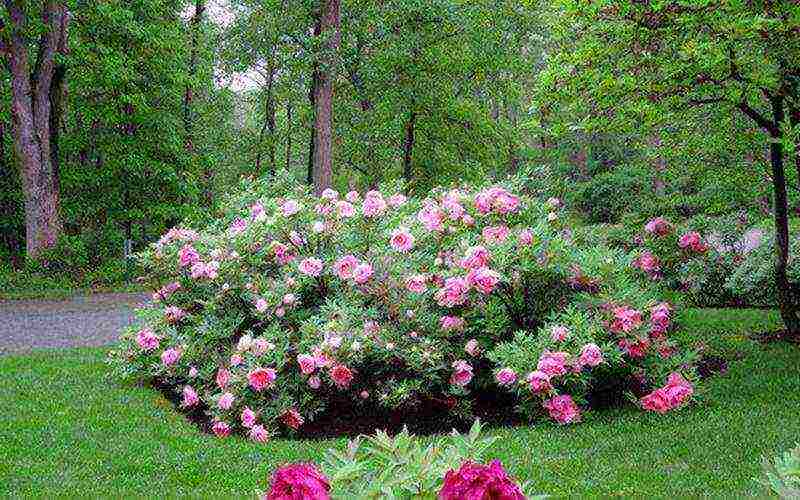
Tree peony 'Irina' in the photo
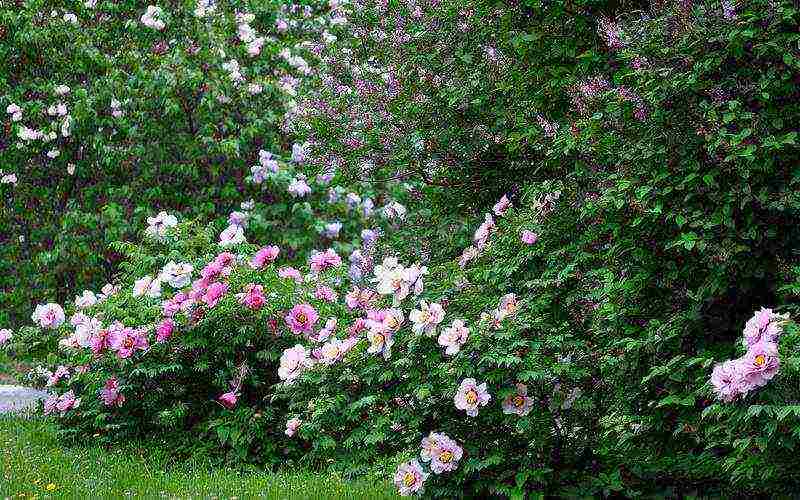
'Stefan' tree peony pictured
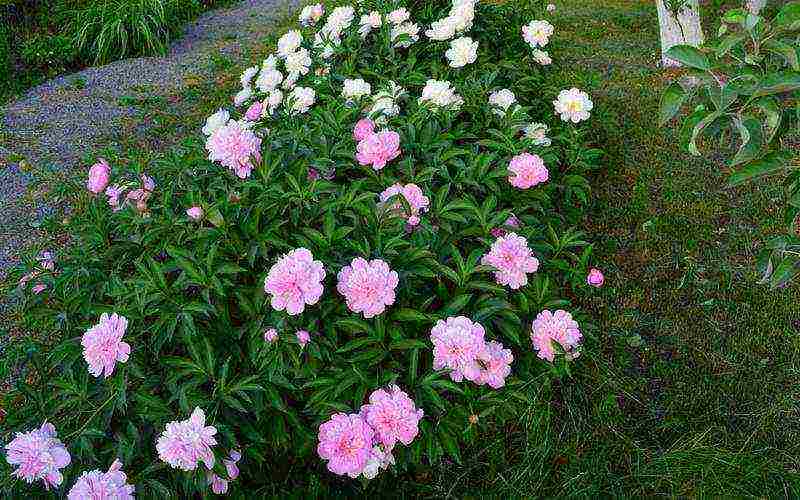
Hoffmann's tree peony photo
Tree peonies in garden landscape design (with photo)
Tree peonies in landscape design are one of the most promising crops for landscaping, since with proper agricultural technology they can grow in one place for 50 or more years. Peonies can be recommended both for personal plots and for landscaping squares and parks. Among perennial plants, there are few that could compete with them in longevity and unpretentiousness. The buds of tree-like peonies resemble a rose, and during the flowering period the plants fill the garden with an unusual aroma, delight us with the beauty and variety of flower colors. Peonies can be used to create rock gardens, large landscapes, to decorate parks and garden plots. They can be planted both in groups and singly on the ground. Peonies look spectacular against the background of conifers (for example, silver fir trees) or next to architectural structures.
See how beautiful tree-like peonies in the garden are in these photos:
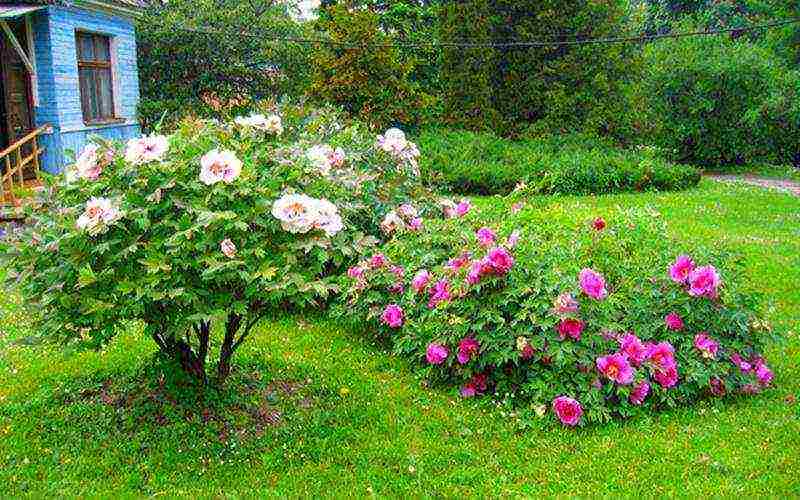

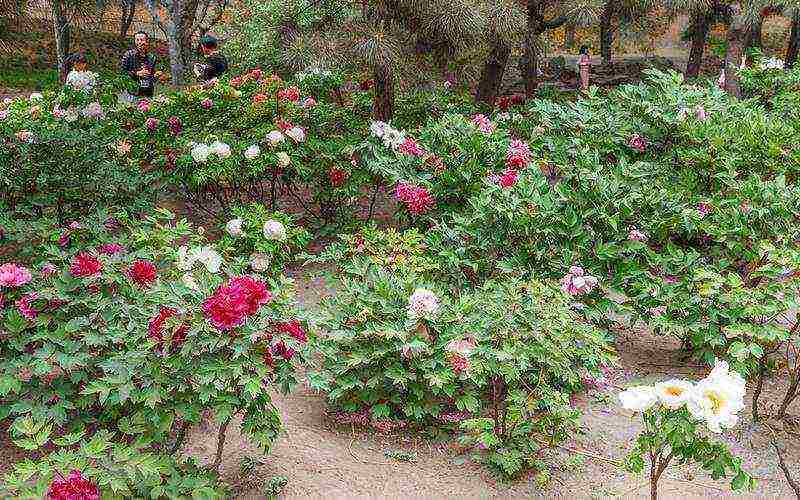
These crops bloom simultaneously with lilacs and chestnuts - it is no coincidence that many gardeners plant them nearby.
Between the bushes of peonies, you can plant woodlands, tulips, daffodils, crocuses. When these early spring plants have faded, the leaves of the regrown peonies will completely cover them.
In large parks, peonies are used to get colorful spots, but it is undesirable to plant them in a continuous strip on the lawn. When creating a landscape composition, it is necessary to think in advance about the combination of peonies in color and size and general appearance, and not only during flowering, but also in the summer-autumn period. Ceremonial compositions are usually created from one variety of peonies. In mixed plantings, it is desirable to create separate groups from non-double and double peonies.
Despite the fact that the flowering of individual forms is short, skillfully picking up tree-like peonies of various varieties in the garden, you can create a composition of continuous flowering. The first, in the 20th of May, the non-double varieties of the tree peony will bloom, after a few days the double varieties will pick up the baton, and in a couple of weeks the flowering of the yellow peony will begin. When the tree-like peonies fade, they will be replaced by early flowering varieties of herbaceous peonies. As a result, peonies will adorn your garden from mid-May to late June.
These photos show tree peonies in the landscape design of city parks and private gardens:
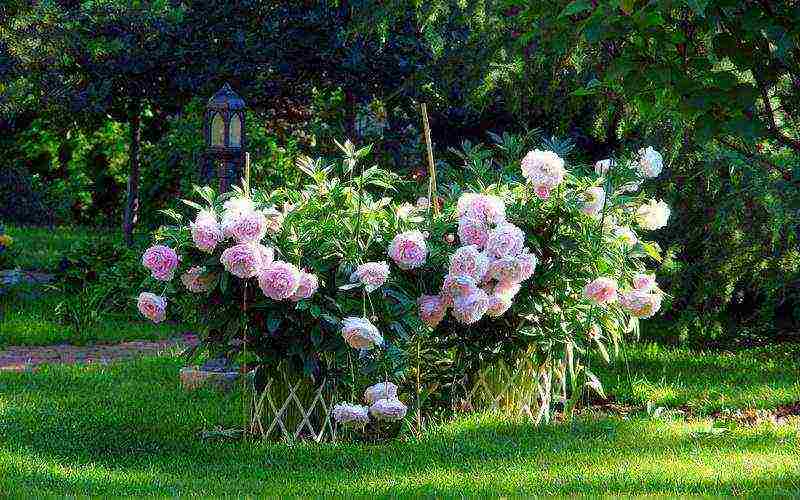


Rate the article:
(8 votes, average: 5 out of 5)
 They say about tree peonies: "They freeze, do not grow, do not bloom ...". Of course, in winters with extremely low temperatures they freeze, and with improper planting and care they do not grow or bloom. Like most other garden plants. But how good!
They say about tree peonies: "They freeze, do not grow, do not bloom ...". Of course, in winters with extremely low temperatures they freeze, and with improper planting and care they do not grow or bloom. Like most other garden plants. But how good!
Before trying to grow a tree peony on your own, it is important to understand what kind of plant it is and what its specifics are. This is a bush with leaves falling in autumn, the height of which, depending on the variety, varies in the range of 1-2 m. The stems have a dull brown color, are not susceptible to dying off in autumn.
The plant is characterized by the presence of openwork, feathery leaves, large inflorescences with a diameter of 12-20 cm. Flowers are:
- terry and simple;
- one- and two-color.
The number of buds on the bushes increases with the "maturation" of the plant. The color appears in May - June, lasts from 2 to 3 weeks in a row. To understand what a garden tree peony looks like, pay attention to the photos below:

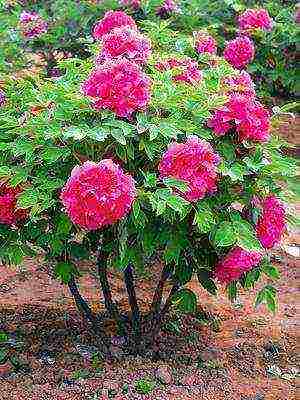


What tree peonies of different varieties look like: photos, names and descriptions
The homeland of these flowers is China. On the territory of this country, thanks to the work of breeders, a huge number of original plant variations have been artificially bred. The differences between them are in the shades of the buds, the degree of their doubleness, the level of frost resistance. Below is information about some of the popular varieties of tree peonies with photos and official names:
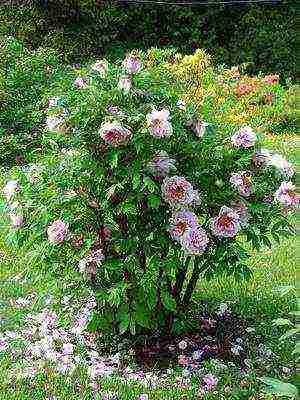
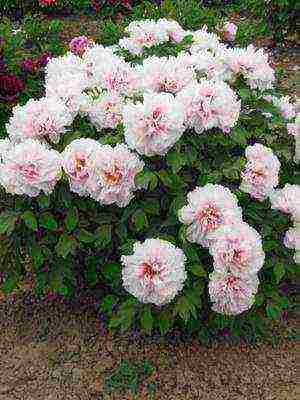
"Sapphire": called the king of gardens. The shrub reaches a height of 1.2 m. The leaves are large, the inflorescences are large (about 18 cm). Flowers appear in June. They have a pink tint, and the center is colored crimson. The tree peony of this variety blooms very profusely - up to 50 fragrant buds appear on one shrub.
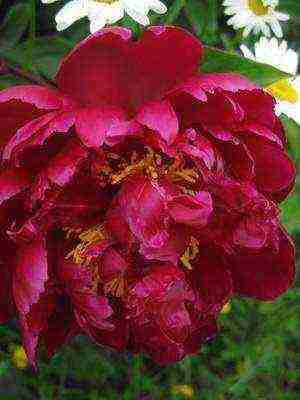
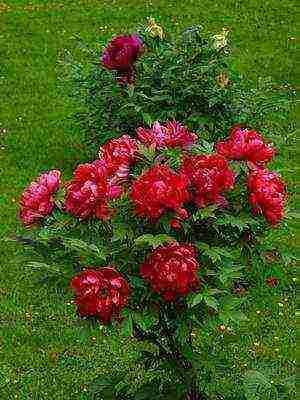
"The deep blue sea": this plant can grow to about 1.5 m in height. Its specificity is that the castings remain green until mid-autumn. The color appears in mid-June and lasts about 14 days. The description of the inflorescences of the tree peony of this variety is as follows: diameter - about 17 cm, shade - purple-red, the number on the bush - up to 50 pieces.
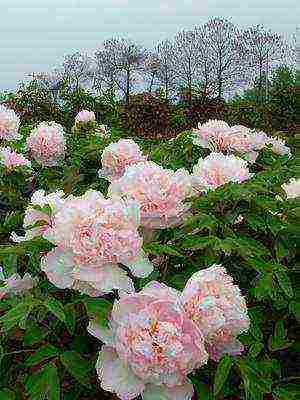

"Snow Pagoda": the shrub can reach a height of one and a half meters. It begins to bloom from mid-June. Fits well into various landscape compositions with contrasting shades. The description and photo of flowers of this variety of tree peonies confirms what has been said. Feel for yourself the ideal beauty of these white and soft creamy buds, reaching a diameter of 16 cm, capable of bringing a touch of freshness to any "green corner".

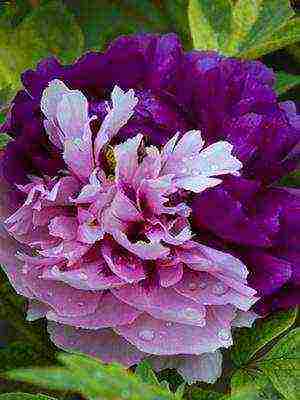
"The Qiao Sisters": grows up to 1.3 m in height. Blooms throughout June. Belongs to the category "the best varieties of tree peonies", because it surprises with its unique color: one half of the bud is painted in creamy white, and the other - in purple-red. Inflorescences are large in diameter - at least 16 cm. Ideal for single and group planting.
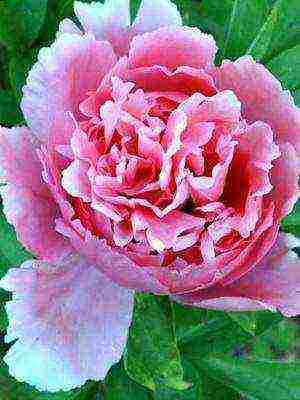
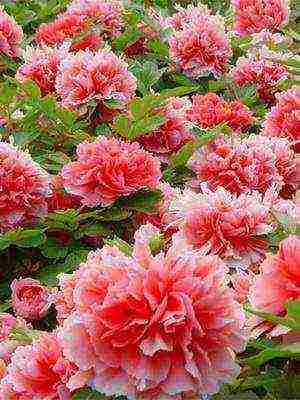
Coral Altar: the height of the shrub is about one and a half meters. The flowering period is in June. Make sure with the help of a photo that the tree-like peony of this variety really looks like a coral: the flowers are crown-shaped, painted in salmon-white shades, large ones have a 20-centimeter diameter.
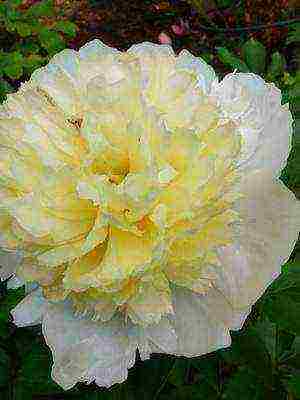
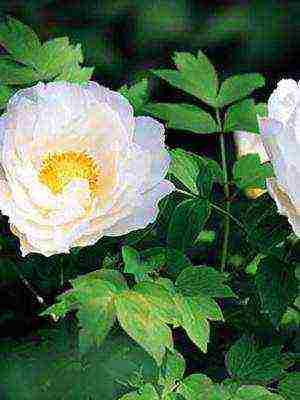
"Primavera": is one of the oldest varieties, the history of which has been going on for over a century. It blooms in May (the name is translated from Italian as "spring"). Check out the description of the tree peony and make sure of its uniqueness with the help of a photo: buds 20-25 cm in diameter with a delicate color - a yellow core and white petals - are slightly similar to daffodils.
Let the description of varieties of tree peonies presented above help you choose the best decoration for your garden and inspire you to create your own landscape masterpieces.
How to properly plant a decorative tree peony
How and when exactly to plant a tree-like peony is a question that interests every gardener, who for the first time decided to diversify his site with such an ornamental plant. Planting time is determined by what type of seedling was purchased:
- with a bare rhizome (i.e., with open roots);
- with a closed rhizome (growing in a container in a substrate).
Those seedlings with closed roots can be planted in the ground in both spring and autumn. When planted in spring, flowering occurs in the same season.
If the bark system is open, then such tree-like peonies, like all herbaceous ones, are planted in the soil in August - September. Only here's the bad luck: the seedlings go on sale not at this time, but in early spring or even in February. Of course, you can buy peonies at this time.In skillful hands, they will hold out until they land in the ground and take root. But plants from such seedlings most often get sick and lag behind in development, and the color appears much later. This is due to the fact that small roots are not yet formed on the completely bare roots, intended for the absorption of nutrients. For their formation, the shrub must remain in the ground at low "plus" temperature indicators. Therefore, it is worth purchasing tree peonies in winter and spring with an open root system only if a very rare variety has turned up.
If, nevertheless, you bought a seedling with a bare rhizome in the spring, before planting a tree-like peony in open soil, you must follow the so-called "intermediate planting" - that is, in a container - and leave the flower until autumn:
- It is necessary to take a container, the volume of which is at least 5 liters, and the bottom has holes for water drainage, put drainage in it, and then fill it with non-acidic soil. After the seedling is placed in it.
- In the spring months, the cultivation of a tree peony seedling is recommended to be carried out on the balcony or in the basement, where the air temperature will be "plus", but close to 0 ̊С. Watering will need to be sparse, only in order to prevent the soil from drying out. The seedling should not be allowed to grow, because the suction roots will not be able to form.
- When the shoots reach a height of 15 to 20 cm, the plant should be transferred to a well-lit room, but just as cool. Growing a tree peony seedling requires the following care: watering must be kept to a minimum, and if the first leaves appear, you should immediately treat the peony with "Fevorit".
- With the arrival of the summer season, it is recommended to take the seedling out to a cool corner of the garden, but protected from drafts and direct sunlight.
- During August - September, it can be moved to a place of stable growth.
For this plant, you need to choose places protected from the wind. The optimal planting for tree peony bushes is next to conifers, it is also advantageous from an aesthetic point of view. It is performed using the following technology:
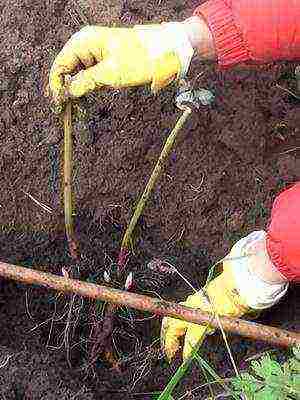
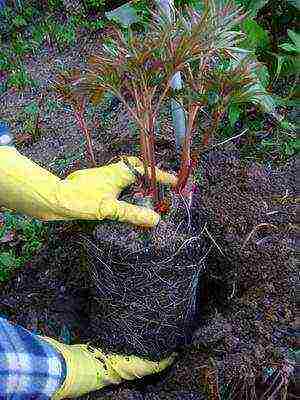
A hole for the plant must be dug 14 days before planting so that the soil settles well.
Planting pit parameters: depth - 50 cm, diameter - 40 cm, distance between several pits - from 1 to 1.5 m.
The bottom should be laid out with expanded clay, sand or gravel drainage, the optimal layer thickness of which is from 20 to 30 cm.
It is recommended to take non-acidic soil, stir in peat or compost + humus + sand (in a ratio of 1: 1: 1). The addition of 0.2 to 0.4 kg of bone meal is also allowed.
All buds that appear on the seedling must be removed. To understand how to properly prune a tree peony before planting, watch the video below.
Part of the previously prepared soil must be poured onto the drainage. If the seedling was with a closed rhizome, it is transplanted with a clod of earth, and if with an open one, the roots are carefully spread over a layer of earth and watered with 4 or 5 liters of clean water. After absorbing the liquid, the rest of the soil is poured into the pit and compacted (not very tightly). It is necessary to ensure that the root collar of the bush is located flush with the ground.


The final stage is mulching the plant using peat or humus while deepening the root collar by 4-5 cm.
You can immediately fertilize the bush by adding superphosphate to the soil mixture or liquid fertilizer to the water for irrigation. How to plant a tree peony step by step, look at the presented photos:
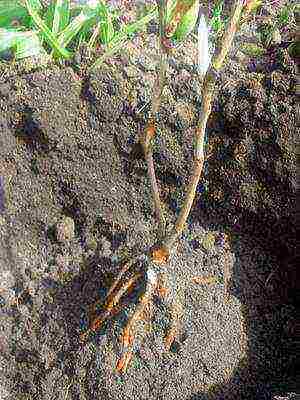

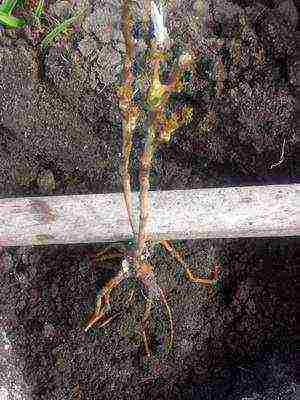

How to grow tree peonies and how to care for them
When growing peonies, the following rules must be observed. These flowers require abundant watering in the spring and just before flowering, if the soil is slightly moistened. Otherwise, moderate watering is required.During the summer, its intensity should be reduced, and in August it should be stopped altogether so that the wood has the opportunity to "prepare" for wintering.
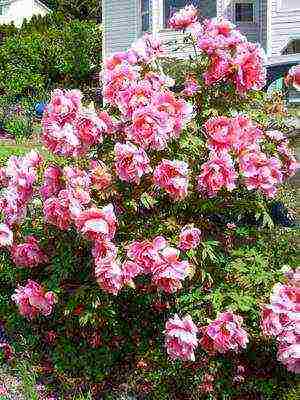
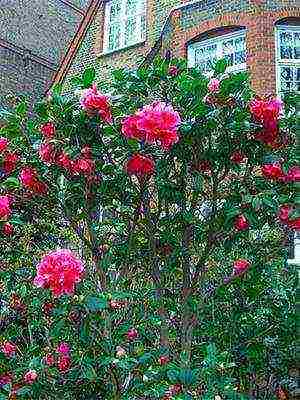
When organizing proper care for a tree peony, it should be remembered that it is not recommended to water it with very cold water. It should be kept in a container where it can pre-warm up in the sun. You need to pour the liquid in portions, so it can get to the root system, and not spread on the surface of the earth.

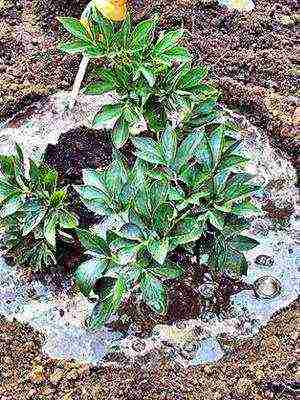
Another important aspect of growing a plant is timely and correct feeding. In order for it to give abundant color, fertilizer should be added once every 12 days: starting in April and until the color falls. And when planting a tree peony, and for further care for it, ash, mineral supplements with predominant potassium and phosphorus components, and bone meal are widely used as top dressing. This will at the same time prevent the development of diseases in the plant.
In general, diseases do not bypass peonies. The biggest problem is root and foliage rot. At the first signs (spots on the leaves, sporulation, bronze color of the leaves, etc.), it is necessary to apply fungicides.


Every plant breeder who cares about the state of his garden is interested in how to care for a tree peony, preparing it for winter. With the wintering of tree peonies, things are like this. Young plants that are completely covered by snow are not afraid of anything. In principle, when there is a nice snowy winter with moderate temperatures, tree peonies do not suffer. But in severe frosts, parts of the plant that are above the level of the snow cover may freeze out. Therefore, in October, it is recommended to mulch the soil with a bucket of peat or the same amount of humus per bush, cut off the leaves by two-thirds of the plant's length and cover the bushes with special material, leaving holes for air to enter. A shelter for large bushes is constructed as follows: a hut is made from sticks, which is wrapped in lutrasil or covered with spruce branches.
In mild winters, plants under cover can be affected by fungal diseases. You can do without shelter, because winters that are really critical for tree peonies happen here once every ten years.
In addition, under the weight of the snow, the bushes of tree-like peonies sometimes break. Therefore, it is better to tie large specimens. How to properly perform care and tie up a tree peony is clearly demonstrated by the photo:
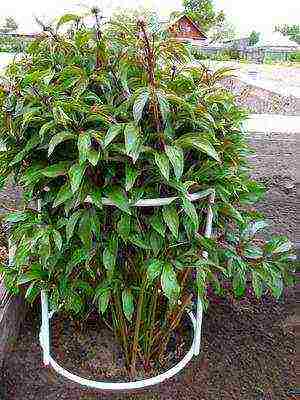
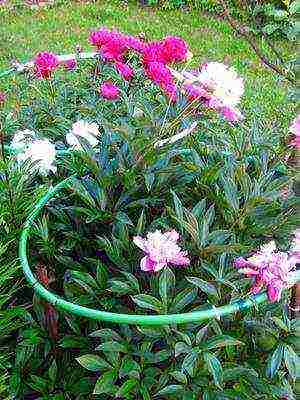
If at the end of winter there are frozen buds on the bushes, then you should not remove them immediately. If at the beginning of June they cannot recover, then it is worth pruning the shoots that have frozen to the first active bud. As the photo below testifies, tree peonies, planting and caring for which are organized correctly, give abundant color to lush buds - appreciate their magnificence and unsurpassed.
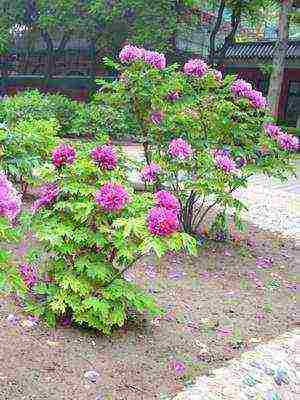
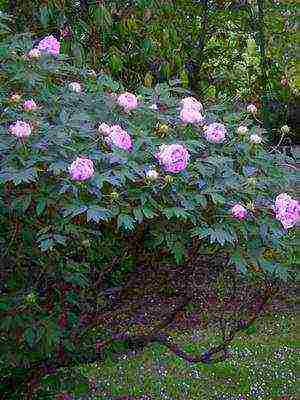
Methods for propagating peonies by seeds and cuttings
Despite the fact that the seedlings of this luxurious plant are inexpensive, many amateur gardeners practice reproduction of the tree-like peony growing on the site on their own. There are several ways to accomplish this procedure:
- Seeds: this option is often used by breeders, since seedlings take a long time. Seeds must undergo double stratification, that is, stay two winters in a row in the ground, in the natural environment. After the first wintering, a root system is formed in them, and only after the second, stems and leaves appear. The first color appears 4 or 5 years after sowing. If a tree-like peony species grows in your garden, in order to propagate it by seeds, it is enough to leave a few seed heads, allowing the seeds from them to spill out into the ground after final ripening. You can also pre-collect and sow them in the area of the site in which you need.Planting sites should in any case be noted and watered regularly during dry periods, despite the lack of seedlings.
- Cuttings: this option is also considered simple, but not effective enough. The procedure should begin in late spring - early summer. It is necessary to select parts of the shoot that have a bud and a leaf and are only half woody, cut them off and place them in a root solution for a couple of hours. Then you should plant the cuttings in a box filled with a mixture of sand and peat in a 1: 1 ratio, covered with a film. Planting depth - 1.5 cm, angle - 45 ̊. Rooting will occur only by mid-autumn. At this time, it is necessary to transplant them into a greenhouse for wintering. It is necessary to plant a tree-like peony, which was propagated by cuttings, in open ground in the spring. The color will appear around the 5th year.
How to propagate tree peonies by division, layering and grafting
It is fashionable to propagate peonies in other ways:

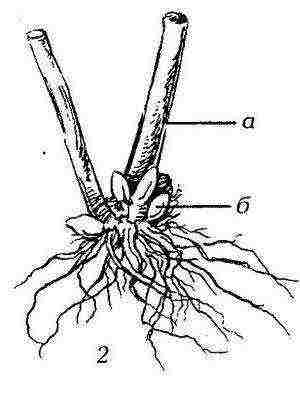
Dividing the bush: this method is included in the list of the least difficult and most effective. But if the choice falls on him, he will have to sacrifice one mother bush, "making" several small plants from one large one. It is recommended to choose bushes for this, the age of which does not exceed 6 years, the best option is a 4-5-year-old plant with at least 7 independent stems. Before propagating a tree-like peony by dividing the bush, it must be cut to 10-15 cm in height, then dug out, washed off the soil from the roots, shaken thoroughly, and decayed and very old roots removed. Next, it is necessary to cut the rhizome into several divisions so that the root of each of them has a length of about 10 cm or more, and the stem has from 3 to 5 buds. It is recommended to treat all cut zones on the rhizome with a solution of potassium permanganate and sprinkle with a mixture of charcoal and colloidal sulfur in a 1: 1 ratio. The cuttings prepared in this way must be planted immediately in the ground and flowering can be expected in two years.

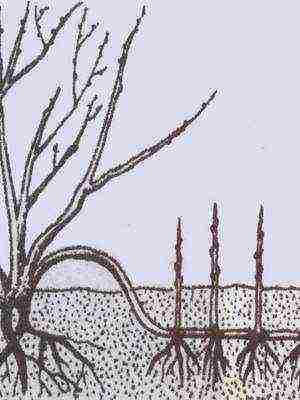
By layering: the named method is also among the simple ones, like all the previous ones, but at the same time it is unproductive. You need to dig in the layers at the end of spring, until flowering begins. For this procedure, the shoot that is closest to the soil is suitable. At the very bottom, you need to make a small incision on it, which is processed with a root. After that, the layering must be leaned against the soil and covered with a 10-centimeter layer of soil. The gardener's task is to carefully ensure that the earth does not dry out. Rooting will take place somewhere closer to September - then it can be cut off from the mother bush and transplanted into the selected area of the garden. The reproduction of a tree peony by layering is clearly shown in the video:
Vaccinations: this option is the most troublesome and time-consuming. Most often, the rootstock is the roots of herbaceous peonies, and the scion is the young shoots of tree-like ones. It is necessary to sharpen the scion in a wedge, and cut a hole in the required shape in the rootstock. It is also possible to carry out the vaccination from the side. To do this, it is required to cut off both the stock and the scion at a slight angle, and then connect them and firmly fix them with polyethylene or electrical tape (the adhesive surface is outward). When wondering how to grow a grafted tree-like peony, you need to take into account that the plants grow together for 1 month, then they should be grown in a greenhouse for 2 years.
Since tree peonies reproduce by grafting, cuttings, layering, seeds and dividing the bush, then any gardener has the opportunity to choose the most convenient way for himself or to experiment with everyone.
The use of tree peonies in landscape design
Growing a tree-like peony, amateur and professional gardeners versed in landscape design use the plant both as a component of original "live" flower arrangements, and as a bright, self-sufficient single decoration of their own plot.
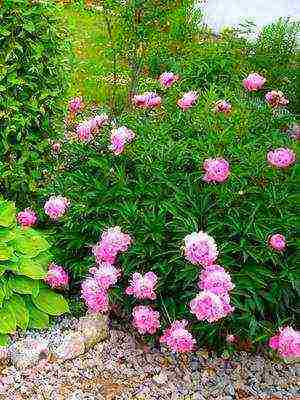

If there is a desire to plant one bush, it should be borne in mind that it will look most successful on a spacious, open area of the backyard area. Low, small, discreet flowers can be placed around it, or the entire lawn can be sown with decorative grass. How a single tree-like peony looks on a juicy green "carpet", evaluate in the photo.

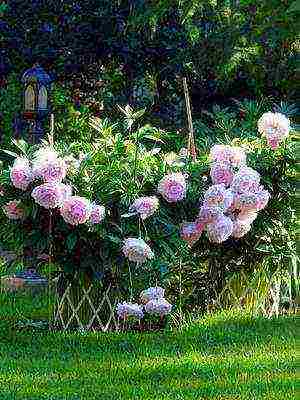
If you are thinking about how to organize a group planting of plants to decorate your site, then pay attention to the recommendations of specialists:


You can use several varieties of tree peony to create a flower garden composition at the same time, planting them in one row. They will make an original lush hedge.
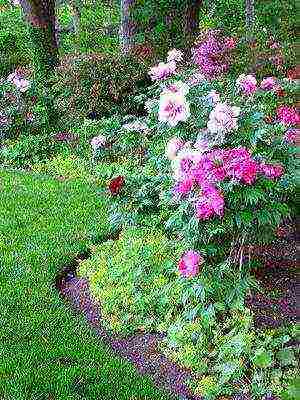
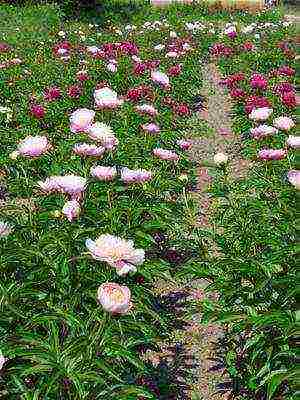
A very popular method of alternating them with other shrubs about 1.5 m high - hydrangea, Japanese spirea. How luxurious a tree-like peony looks surrounded by these flowers, look at the photos below.
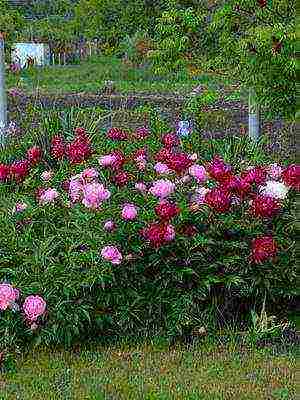
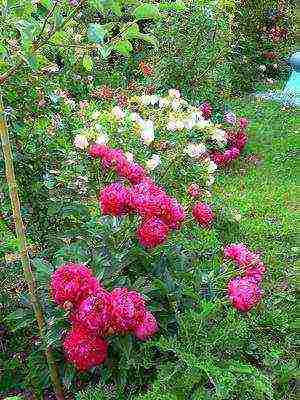
Peonies look gorgeous in the "heart" of the site if flowers are additionally planted along its edges in even rows, the shades of which represent the same color palette as the shade of the peonies.

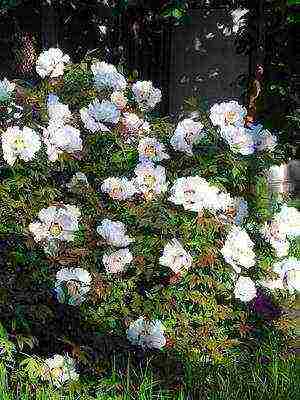
To create flower beds, it is important to use plants, the flowering period of which coincides with the period of the appearance of color in the tree peony. If the latter blooms in spring, tulips can make an ideal tandem with it, but if in June, then nigella, nasturtiums, daisies, petunias will become excellent "neighbors" for it. Appreciate the uniqueness and beauty that the tree-like peony, called the "imperial flower", creates in the landscape design in the photos below.
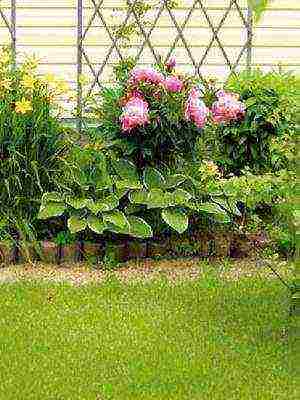
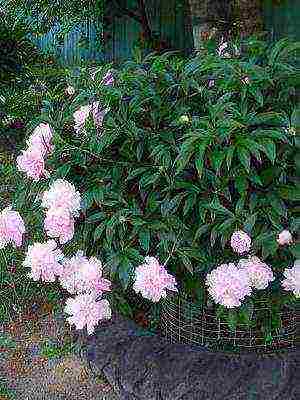
An interesting solution is to decorate the flower bed with decorative stones, which turns the flower garden into a real creative masterpiece.
In order to avoid mistakes in the design of your site, it is better to draw the future composition on a sheet of paper with precision to the smallest detail, and then proceed with its implementation. Growing this plant is a very simple and rather interesting activity, and the result can be truly great pleasure.
Watch the video on how to organize the cultivation of a tree peony on your site, and listen to the valuable advice of professionals:
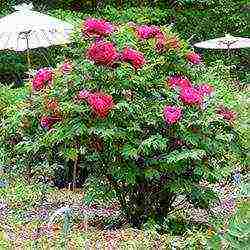 Treelike peonies open the fragrance season of large-flowered solitary perennials. Online store catalogs offer up to 600 different varieties of this delightful plant. The proposed article will help you understand their classification and choose the right one with the help of high-quality photos. Get acquainted with the names of varietal variations and their descriptions, choose a place in the garden for planting a peony and enjoy its aroma and delicate colors of innocence.
Treelike peonies open the fragrance season of large-flowered solitary perennials. Online store catalogs offer up to 600 different varieties of this delightful plant. The proposed article will help you understand their classification and choose the right one with the help of high-quality photos. Get acquainted with the names of varietal variations and their descriptions, choose a place in the garden for planting a peony and enjoy its aroma and delicate colors of innocence.
Tree peony - distinctive features
The colossal variety of varieties and varieties of tree peonies is divided into three garden groups. This type of peony, seen and introduced into the culture in the Middle Kingdom, is otherwise called semi-shrub. It has a number of differences from herb that you should know before purchasing in order to provide it with proper care.
- Woody stems. They cannot be cut into a stump in the fall, as is done with herbaceous ones. For the winter, the bushes of tree peonies are wrapped in agrofibre, and cut off after the snow melts. A transplant is planned for the fall, and vaccination is chosen as a breeding method.
- The height of the bush. Every year, the tree-like peony increases its habitus, therefore it requires more space.
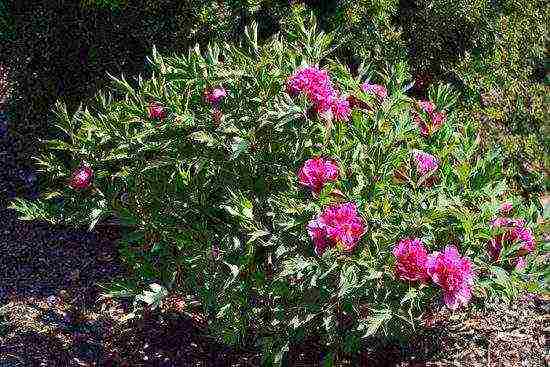
Tree peony requires specific care
- The original shape of the flowers. It looks most impressive in a single planting in front of conifers or a dark-leaved tree such as a horse chestnut.
Advice. To create a romantic corner in the garden with the help of a peony, plant it against the background of the light wall of the gazebo, surrounded by small-flowering ground covers.
Sino-European peonies - drooping giants
In the group of Chinese-European peonies, selection is made for the size and doubleness of the flowers.They are much larger than others, have dense petals of all shades of rose, peach, salmon, lilac. However, the flowers are so heavy that the stems droop during flowering, sharply reducing the decorative effect of the culture.
The following varieties of Chinese-European peonies are of interest:
- Red giant. The bush grows 180-190 cm. The flower is of expressive coral color, crown shape, size 16 × 7 cm. The variety is distinguished by active growth and multi-flowering, blooms towards the end of the season. Slightly drooping.

Red giant
- Transparent dew. A medium-sized variety (up to 150 cm) with pronounced double flowers measuring 18 × 7 cm. The color is pale lilac in the center and delicate mother-of-pearl on the periphery. It blooms late and has a very delicate odor.
- Blue sapphire. Giant, up to 25 cm, flowers on low stems. The color is pale pink, the name of the variety is given for the distinct bluish tint of the edges of the petals, which appears with proper care. Strongly drooping, requires strengthening and a garter.

Blue sapphire
Other varieties should be mentioned:
- Taoist temple - blood-scarlet semi-double;
- Green ball - with Chinese cabbage-colored petals;
- Peach under the snow - with the shape and color of a lotus;
- Pink lotus - salmon color with a bright center of black and yellow stamens.
Attention! Peonies of all varietal groups love slightly alkaline soil, therefore, before planting, the soil must be filled with dolomite flour.
Japanese peonies are modest beauties
Japanese tree peonies are good for their increased winter hardiness, which is in demand in regions with a harsh climate. These are non-double and semi-double plants with somewhat smaller flowers, but light and less prone to drooping. The common form of the flower is anemone. Among the "Japanese" the following varieties have gained popularity.
- Gold placer. Each pale yellow petal is framed along the contour with a salmon-colored border, forming a lace flower with whimsical pink lines. Size 20 × 7 cm. Blooms late.

Gold placer
- Koshino-yuki. It is considered the best white variety in the world. The size of the flower is 20 × 7 cm. Initially greenish, when blooming, the bud takes the form of ivory, and then - untouched snow.
- Black Panther. A low, up to 110 cm, shrub decorated with deep burgundy flowers with a golden center, 19 × 8 cm in size.
- Shima-nishiki. One of the most spectacular varieties. The compact bush is strewn with large (18 × 8) flowers of such a color, as if milk was poured into strawberry jam and stirred a little.
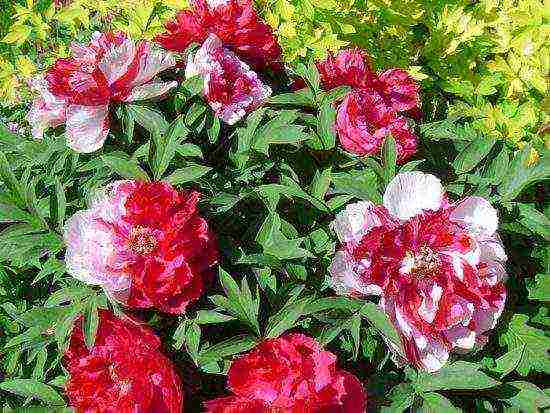
Shima-nishiki
Such varieties also look great in the garden:
- Yellow Yao - with pale cream strongly convex flowers;
- Midday heat - unusual for lemon-colored peonies, sometimes blooms again in August;

Midday heat
- Primavere is like a lemon canary fluffed up with feathers;
- Two sisters - with unique two-tone flowers, from tender pink on one side to deep purple on the other.
Advice. Peonies are very moisture-loving; it is almost impossible to fill them in well-drained soil. Give each bush a whole bucket of water - and you will be rewarded with luxurious flowering.
Delaway peonies - solar hybrids
This group of tree peonies is represented by hybrids of two types: yellow and Delaway. As a rule, they have a simple non-double flower, close to the original shape, and a color of yellow shades. Popular are:
- Academician Sadovnichy (Russia) - the color of butter with a raspberry "signal" inherited from the wild form at the base of each petal.
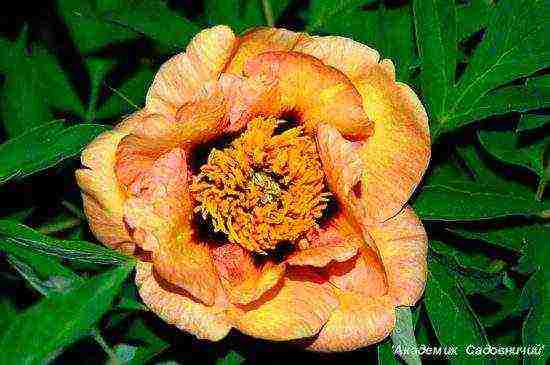
Academician Sadovnichy
- Souvenir de Maxime Cornu (France) is an unsurpassed densely doubled flower, pale yellow with carmine edging of petals.
Domestic breeding peonies
Professionals of the Moscow State University Botanical Garden and amateur flower growers have bred many varieties of peonies with excellent decorativeness and the ability to withstand Siberian or Far Eastern winters. Among them are especially good:
- Anastasia Sosnovets - small (11x5 cm), but spectacular white two-row flowers with bright spots of magenta;
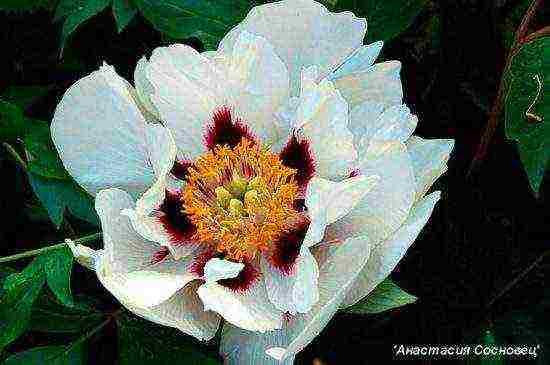
Anastasia Sosnovets
- Kuindzhi - elegant tall (up to 120 cm) bush with light foliage, creamy yellow flowers;
- Nikolay Vavilov - with wide (up to 20 cm) simple purple flowers;
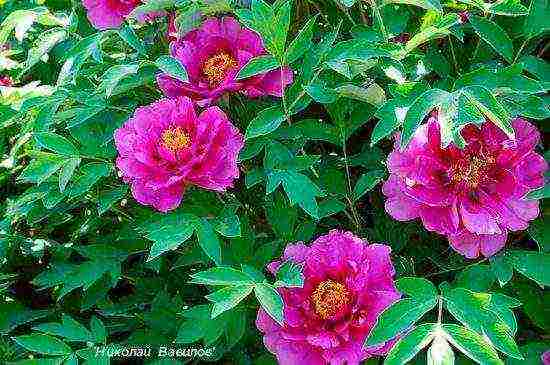
Nikolay Vavilov
- Titus Trofimov is a semi-double pink flower, the color intensity of which increases towards the center;
- Julia Drunina - scarlet petals with a blueberry spot at the base.
In terms of decorativeness, the tree peony has few competitors. A large, well-groomed shrub with glossy foliage is impressive outside the flowering period. The grandiose world collection of tree peonies allows you to choose a flower of any color and degree of terry for your garden.
Tree peony: video
If you love peonies as much as we love them, this article will not leave you indifferent. We offer a selection of luxurious tree peony varieties for every taste and color!
Tree peonies are incredibly beautiful and fragrant. During flowering, they are unlikely to be found equal among their "colleagues" in the flower world. True, most often in the gardens you can see only pink, red and white peonies. What about purple, yellow, or even black?
Coral altar
Peonies of the Coral Altar (Shan Hu Tai) variety are notable not only for the unusual color of the petals (from pale pink to rich coral), but also for the bizarre shape of the leaves.
They do not require shelter for the winter, do not have special care requirements, and are resistant to diseases and pests.
| Appointment | Petal color | Bush height (cm) | Flowering time |
| Coral pink | 120-150 | First half of June | |
Koshinoyuki
The Koshino-yuki peony belongs to the Japanese tree peony cultivar group. This handsome man has won awards as the best white peony. The unopened buds of this peony, with their greenish tint, resemble white cabbage. As they open, the petals change color from ivory to snow-white.
Luxurious large flowers bloom surrounded by beautiful foliage of rich green color.
| Appointment | Petal color | Bush height (cm) | Flowering time |
| white | 120-150 | End of June - beginning of July | |
Primavere
The Primavere variety is over 100 years old. Despite the fact that it was bred in France, it belongs to the Japanese group of varieties.
Its delicate color fully justifies the name of the variety, which in translation from Italian means "spring". The petals of a pleasant canary shade in the center of the flower are surrounded by milky white at the edges. Isn't it very much like a reference spring flower - daffodil?
During flowering, Primavere peonies give off a delicate, pleasant aroma. The flowers themselves are very large - about 20-25 cm in diameter.
| Appointment | Petal color | Bush height (cm) | Flowering time |
| In the center of the flower - pale yellow, along the edges - white | Up to 90 | Mid to late June | |
Purple phoenix
The name of this Chinese variety of peonies literally translates as the Purple Phoenix Flying to the Sun (Zi Feng Chao Yang). These peonies bloom very effectively, exuding a delicate, pleasant aroma.
Like other plants in this group, Purple Phoenix shrubs are resistant to low temperatures, disease and pests.
| Appointment | Petal color | Bush height (cm) | Flowering time |
| Purple | 150-200 | Mid june | |
Purple lotus
The purple lotus peony (Shen hei zi) is also a native of China. Young shrubs bloom with dark pink flowers and only in adulthood do the flowers acquire a rich dark purple hue, for which peonies of this variety are valued.
Purple lotus bushes are not afraid of low temperatures, winter well, do not require complex care.
| Appointment | Petal color | Bush height (cm) | Flowering time |
| Purple | 150-200 | Mid june | |
Flower dew
Peony Flower dew (Ling hua zhan lu) during the flowering period is covered with large pink inflorescences with a bluish-purple undertone.
Shrubs of this variety bloom very abundantly in the second half of June.
| Appointment | Petal color | Bush height (cm) | Flowering time |
| Purple | 150-200 | Mid june | |
Black pirate
Black Pirate is a variety of very showy peonies. As you might guess from the name, their flowers are dark cherry with a black tint. Such a plant cannot fail to attract admiring gaze.
The bushes of the Black Pirate are quite compact. They can even be grown in containers.
| Appointment | Petal color | Bush height (cm) | Flowering time |
| Maroon, almost black | 45-90 | Mid june | |
Silk veil
Silk veil is a superfrost-resistant variety of Roca peonies, one of the varieties of tree peonies. In their homeland in China, these peonies are able to withstand temperatures below –30 ° C.
This is a very beautiful shrub with an unusual shape of leaves and an interesting color of flowers: snow-white petals at the base are dark purple.
| Appointment | Petal color | Bush height (cm) | Flowering time |
| Maroon, almost black | 45-90 | Mid june | |
Age of Gold
The Age of Gold peony bushes are adorned with large lemon globular inflorescences. This is a classic variety of American tree peonies.
The plant is drought-resistant, can tolerate a lack of watering with dignity. In sunny and hot weather, the flowers do not fade.
| Appointment | Petal color | Bush height (cm) | Flowering time |
| Lemon yellow | 60 | June | |
We hope this list has inspired you to diversify the peony collection in your garden. You can find out about the rules for planting a tree peony in this article.


